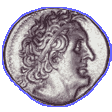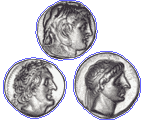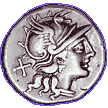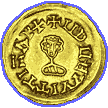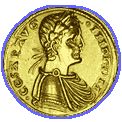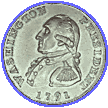
| History
|
|
| The Greeks laid the foundations
for the language of symbolism and text that is still used on coins
to this day. From the early use of dynastic and civic symbolism,
the Greek coinage tradition developed a fully articulated range
of coin types that became associated with the political organization
of the issuing authority. |
|
| The development of realistic portraiture was
a pivotal event in the history of numismatic art as well as in the
development of coins as tools of political power. The ancient world
did not have the printing press—there were no billboards or pamphlets—news
traveled by hand-written letter or word of mouth. Coins were the
media of mass communication par excellence of the ancient world—with
coins a ruler could make known their desired self-image to their
subjects. Hellenistic portraiture went hand in hand with a tendency
to use inscriptions, at first to name the ruler, and later to name
their attributes (‘saviour,’ ‘god manifest,’ ‘the great,’ ‘devoted
to his father,’ etc.). |
|
| The Romans developed the political use of coinage
to unprecedented levels. Rome avoided producing coins of their own
for several centuries—in fact, it was not until the early 3rd
century BC that they began to produce coins based on those of the
Greek cities of Magna Graecia.9
At the same time the Romans continued to use a monetary system based
on the old Italic tradition of rough bronze ingots traded by weight.
This system remained in place with gradual modifications until the
2nd Punic War. |
|
| Roman coinage is particularly interesting because it reflects the gradual change of the Roman state from a Republic to an Empire. This evolution is reflected in the coinage in the development of portraiture 11 (the Romans became masters of realistic portraiture) and a numismatic shorthand for standard legends and symbols representing key social, military, and political concepts. Roman moneyers and engravers became adept at expressing personal and political messages through the medium of coinage.12 |
|
| Rome developed the first fully monetized society in the sense of money being used in the minor daily transactions of the majority of people. The fact that so many people (the Roman Empire at its height included up to 100 million people) regularly used coins meant that there was now an audience much larger than ever before for the messages that could be delivered via coinage. The Romans made full use of this huge audience, building on and refining the achievements of the Greeks in the development of numismatic design and symbolism. The result was a sophisticated and flexible system of inscriptions and symbols on their coinage. The messages conveyed were designed to support the Imperial government through expressions of the military prowess of the Emperor, the loyalty of the army, the happiness of the people, Imperial generosity and so on.13 |
|
|
|
|
| With the beginning of the Renaissance Western
Europeans began to look back to the Ancient World for their inspiration
in art, science, and philosophy. |
|
| The ‘modern’ period of coinage begins at the
beginning of the 16th century
with the introduction of the first large silver coins for regular
usage in Tyrol.20
These large coins were made possible through the large–scale exploitation
of new silver deposits in Central Europe, primarily in Germany.
|
|
| French coinage of the late 18th century is provides an excellent case study for demonstrating the continued importance of coins in disseminating messages about sovereignty. The six livre coin is a classic example of the progressive modification of a coin type to reflect changing political circumstances and perceptions of sovereignty—in this case the change from a monarchy to a republic, and finally to an empire, each with its own distinctive imagery and legends.23 Note the progression of the legends: |
|
|
|
| At the same time as the French were wrestling
with the symbolism appropriate for their changing political situation,
the United States was doing the same in the wake of the American
Revolution. Discussions on the creation of a new mint included debate
on the proposed designs for the new coinage of the United States.
This debate highlighted the perceived importance of the messages
conveyed on a nation's coinage and centered on what symbolism would
be appropriate for a new Republic in a monarchical world. |
|
Last updated: 03/11/2008

